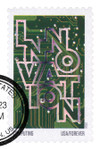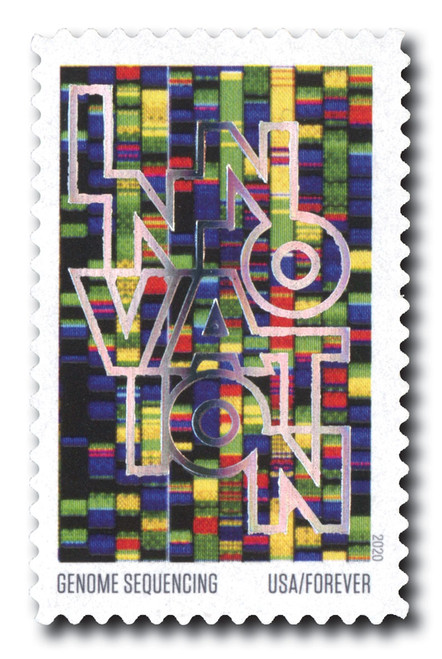
# 5514 - 2020 55c First-Class Forever Stamps - Innovation: Computing
US #5514
2020 Computing – Innovation
- One of five stamps celebrating American Innovation – this one commemorates advancements in the field of computing
Stamp Category: Commemorative
Set: Innovation
Value: 55¢ First Class Mail (Forever)
First Day of Issue: August 20, 2020
First Day City: Bellefonte, Pennsylvania
Quantity Issued: 14,000,000
Printed by: Banknote Corporation of America
Printing Method: Offset, Hot Foil Stamping
Format: Panes of 20
Tagging: Phosphor Tagged Paper, Block Tagged
Why the stamp was issued: To honor the achievements in the field of computing that have helped America grow into the nation it is today.
About the stamp design: Pictures block lettering of the word “Innovation” overlaying an existing photograph of computer circuits. Designed by USPS art director Antonio Alcalá.
Special design details: Hot foil stamping was added to the word “Innovation.” This gives the letters a holographic shimmer and makes them stand out.
First Day City: The First Day of Issue postmark was from Bellefonte, Pennsylvania, but no First Day of Issue Ceremony was held due to the ongoing Covid-19 global pandemic. Instead, the stamps were released during the American Philatelic Society’s Virtual Stamp Show.
About the Innovation set: Includes five stamps honoring the importance of innovation in American history – past and present. Specifically celebrates breakthroughs in the fields of computing, biomedicine, genome sequencing, robotics, and solar technology. Each design pictures block lettering of the word “Innovation” overlayed on exiting photographs related to the theme of each stamp. Stamps were designed by USPS art director Antonio Alcalá
History the stamp represents: In 2020, the USPS issued a set of five new Forever stamps “celebrating the American spirit of innovation.” One of these stamps honors computing.
Since civilization began thousands of years ago, the human race has looked for ways to better calculate and store information. Today, we have sophisticated computers to help us with these tasks. But there have been countless innovations along the way that led to the birth of these machines.
One famous early computing device was the abacus. It was invented in ancient Babylon around 2400 B.C. and is still in use today. Several thousand years later, we had the invention of the printing press. While not directly involved in computing, it dramatically increased accessibility of information, allowing ideas to spread and evolve more quickly.
In the 20th century, significant electronic advances were made that pushed computing forward. These included the transistor, the first computers (huge devices that took up entire rooms), and the launch of the World Wide Web. In the 21st century, personal computers became household staples. Laptops came next, and smart phones followed soon after. It’s amazing how far we’ve come (and how far we continue to go) in our quest for knowledge.
US #5514
2020 Computing – Innovation
- One of five stamps celebrating American Innovation – this one commemorates advancements in the field of computing
Stamp Category: Commemorative
Set: Innovation
Value: 55¢ First Class Mail (Forever)
First Day of Issue: August 20, 2020
First Day City: Bellefonte, Pennsylvania
Quantity Issued: 14,000,000
Printed by: Banknote Corporation of America
Printing Method: Offset, Hot Foil Stamping
Format: Panes of 20
Tagging: Phosphor Tagged Paper, Block Tagged
Why the stamp was issued: To honor the achievements in the field of computing that have helped America grow into the nation it is today.
About the stamp design: Pictures block lettering of the word “Innovation” overlaying an existing photograph of computer circuits. Designed by USPS art director Antonio Alcalá.
Special design details: Hot foil stamping was added to the word “Innovation.” This gives the letters a holographic shimmer and makes them stand out.
First Day City: The First Day of Issue postmark was from Bellefonte, Pennsylvania, but no First Day of Issue Ceremony was held due to the ongoing Covid-19 global pandemic. Instead, the stamps were released during the American Philatelic Society’s Virtual Stamp Show.
About the Innovation set: Includes five stamps honoring the importance of innovation in American history – past and present. Specifically celebrates breakthroughs in the fields of computing, biomedicine, genome sequencing, robotics, and solar technology. Each design pictures block lettering of the word “Innovation” overlayed on exiting photographs related to the theme of each stamp. Stamps were designed by USPS art director Antonio Alcalá
History the stamp represents: In 2020, the USPS issued a set of five new Forever stamps “celebrating the American spirit of innovation.” One of these stamps honors computing.
Since civilization began thousands of years ago, the human race has looked for ways to better calculate and store information. Today, we have sophisticated computers to help us with these tasks. But there have been countless innovations along the way that led to the birth of these machines.
One famous early computing device was the abacus. It was invented in ancient Babylon around 2400 B.C. and is still in use today. Several thousand years later, we had the invention of the printing press. While not directly involved in computing, it dramatically increased accessibility of information, allowing ideas to spread and evolve more quickly.
In the 20th century, significant electronic advances were made that pushed computing forward. These included the transistor, the first computers (huge devices that took up entire rooms), and the launch of the World Wide Web. In the 21st century, personal computers became household staples. Laptops came next, and smart phones followed soon after. It’s amazing how far we’ve come (and how far we continue to go) in our quest for knowledge.










